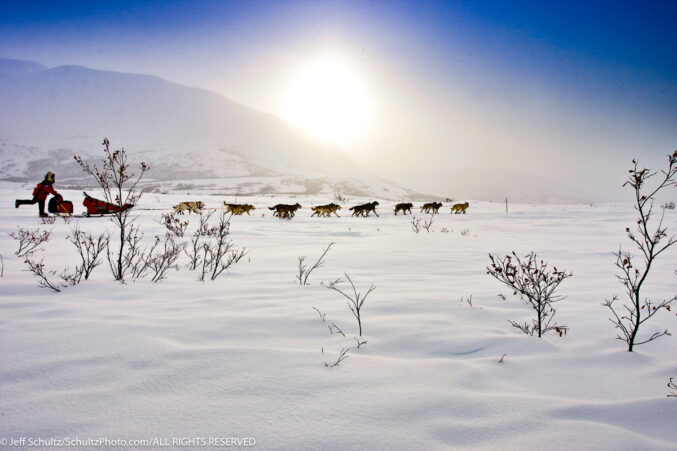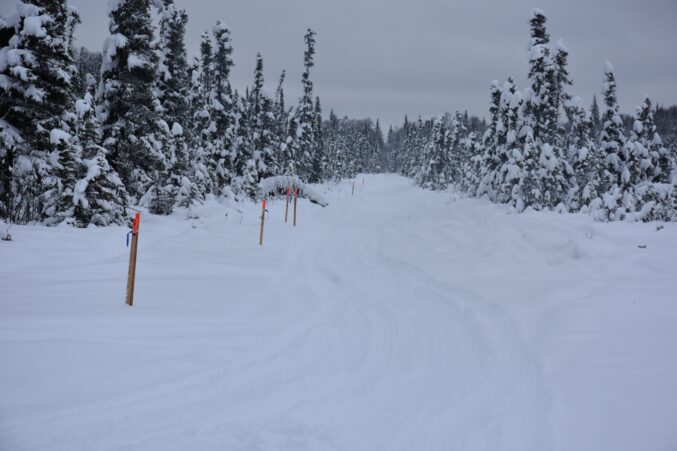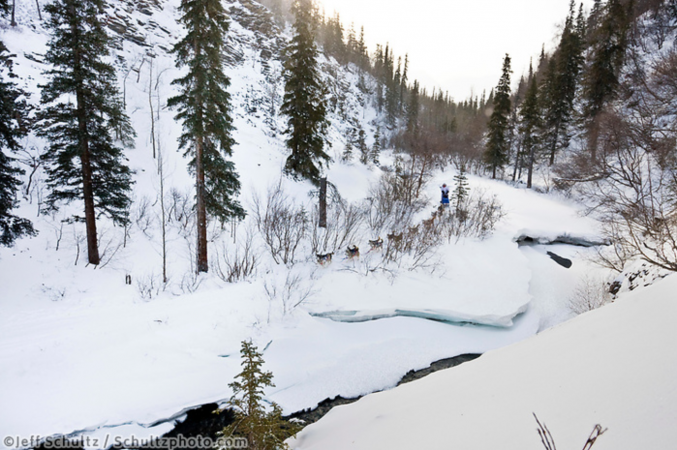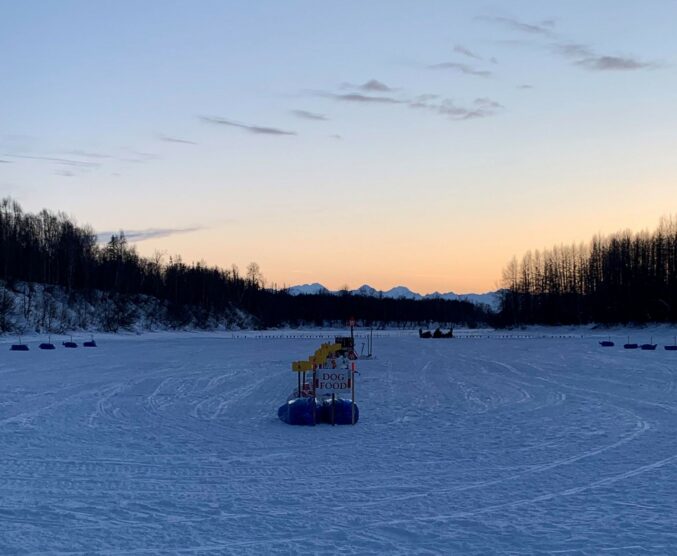Iditarod mushers and their dogs are making their way down the trail! It’s exciting to see the tracker, watch live feed from the trail, and view Insider videos. Iditarod does such an amazing job of helping the public follow along with the race. After watching dog teams come and go on the river at the Skwentna checkpoint, I have a much better understanding of how mushers travel and take care of their dogs. It’s a complex place, so even experienced mushers need a little help to make sure they are on the right track. As I write, the mushers and their dog teams of the 2024 Iditarod are mostly between the checkpoints of Rainy Pass and Rohn. According to the information on the GPS tracker, these two checkpoints have the most beautiful scenery of the whole trail. The original roadhouse at Rohn was a checkpoint on the original Iditarod Trail Mail Route.

Paul Gebhart runs down the trail in Ptarmigan Valley six miles after leaving the Rainy Pass checkpoint during the 2010 Iditarod, Southcentral Alaska. Photo: Jeff Schultz
Trail markers are an important part of any journey. This year’s northern route comprises 24 checkpoints including Anchorage and Nome. Mushers have to consider the nature of each checkpoint when deciding on their run/rest schedule. Some checkpoints are quiet, while others are bustling; some, like Skwentna, provide hot water for the dogs so mushers don’t have to do this time-consuming task. Every year, the mushers vote on the checkpoint they think is the most helpful to them in the race. The winner receives the Golden Clipboard Award. Last year, the winner was the Grayling checkpoint, a point on the southern route.

Race Routes – Northern and Southern Routes. Photo: Iditarod Media
Checkpoints are just one kind of trail marker. Another kind are the unmistakable (pun intended) lath markers that stick up out of the snow about 4 feet high along the route. These stakes are placed along the edge of the trail for the entire 975 miles of the route. The trail is also used for the Iditarod Trail Invitational, a bike, ski, or hiking race, and the Iron Dog, a snowmachine race. When they are made, each stake is tipped with orange, then hand-wrapped with reflective tape. These Iditarod trail markers are iconic and indistinguishable. In the Jr. Iditarod, the trail boss told the teens that he had placed 1200 trail markers, and according to Zuma, Canine Journalist, there are 12,000 trail marker stakes in the Iditarod! Some quick math tells me that on average the stakes are placed every 429 feet along the trail. That’s 1 ½ football fields! The trail breakers that snowmachine all along the trail to place the markers are amazing humans.

Trail markers clearly mark the trail. Photo: Iditarod Media
Yet another kind of trail marker is the scenery the mushers go through. If you haven’t read the trail descriptions on the Iditarod web page, they’re wonderful. While reading, you can imagine how they might look (and the trail descriptions provide a wealth of lesson plan ideas, too). Let’s look at the description for the trail between Rainy Pass and Rohn where the mushers currently race, as I write. Iditarod finisher Don Bowers writes that this portion “is really only about 32 miles and should take three and a half to five hours. It has some very tough trail, including the notorious Dalzell Gorge. Given a choice, most mushers prefer to do this during the day, although a nighttime run is entirely feasible, and with a bright moon can be ethereally beautiful.” He includes a detailed description of this portion of the trail. The mushers have no doubt studied these descriptions carefully, talked to veterans, and researched weather conditions. As they go along the trail, a trail marker might be a scene that shows they’ve gotten through a hard part: ” You’re probably going to spill the sled more than once on the stretch down Pass Fork, so hold on tight. This part of the trail is often in pretty bad shape, with pits and ruts and bumps. Five miles after the summit you’ll come into the wooded valley of Dalzell Creek for a couple of miles of fairly easy running.”

A team mushes along Dalzell Creek in the Dalzell Gorge on the trail between Rainy Pass summit and Rohn during the 2010 Iditarod, Southcentral Alaska. Photo: Jeff Schultz
Trail markers are a vital way for students to know they are on the right track with their learning. One of the goals my district is initiating this year is improving teachers’ ability to implement personalized learning for students. What that means is that students are able to study at their own rate and depth to cover the material, whenever possible. Instead of a quiz that takes days to grade and return, modern technology and the innovations of good teachers have made it possible for students to check their own progress along the way, so that when they get to the quiz, they know they’ve learned it. The quiz returns quick feedback, and students can track their own progress. When I was studying for my teacher exams, practice questions I got wrong taught me a lot more than the ones I got right.
You can create trail markers in lots of ways for your students. Try using individual goal sheets, graphs of class progress posted on a school-wide bulletin board, or individual trackers displayed in the classroom. What’s nice about individual trackers is that the students can do it themselves, putting the responsibility on them to decide how and when they are going to reach the checkpoint by a certain time. Sometimes my students struggle with a checkpoint where they have to write in a certain way, unlike math where you have to get the correct solution. Create success criteria and discuss it prior to the activity so students know by comparing their work to the success criteria that they’ve accomplished the goal. For any content, students can set goals and track their own progress, just like the mushers do. And just like the Iditarod Trail, trail markers can be checkpoints, orange-topped stakes, or that beautiful moment when the scenery changes and you know you’ve conquered a hard part of the trail.
Lots of side benefits go with using trail markers: passing checkpoints or hard parts can build confidence. Trail markers can also help students break down a big assignment or learning path into smaller chunks. This helps them focus on the task at hand rather than become overwhelmed by the big picture. And of course, don’t forget the scenery. The Iditarod Trail is immensely gorgeous with incredible places. As many mushers will tell you, the scenery is one major reason they love the trail so much. You can grant student access to a series of scenic Alaska trail photographs, one more beautiful than the next, as students finish their goals. They will get to experience the same struggle and joy that the mushers do as they make their way down the trail.

A welcome sight as mushers pull into Skwentna. Photo: K. Newmyer
I’d love to know some of the ways you use trail markers for students in your class! Email me at emailtheteacher@iditarod.com.


